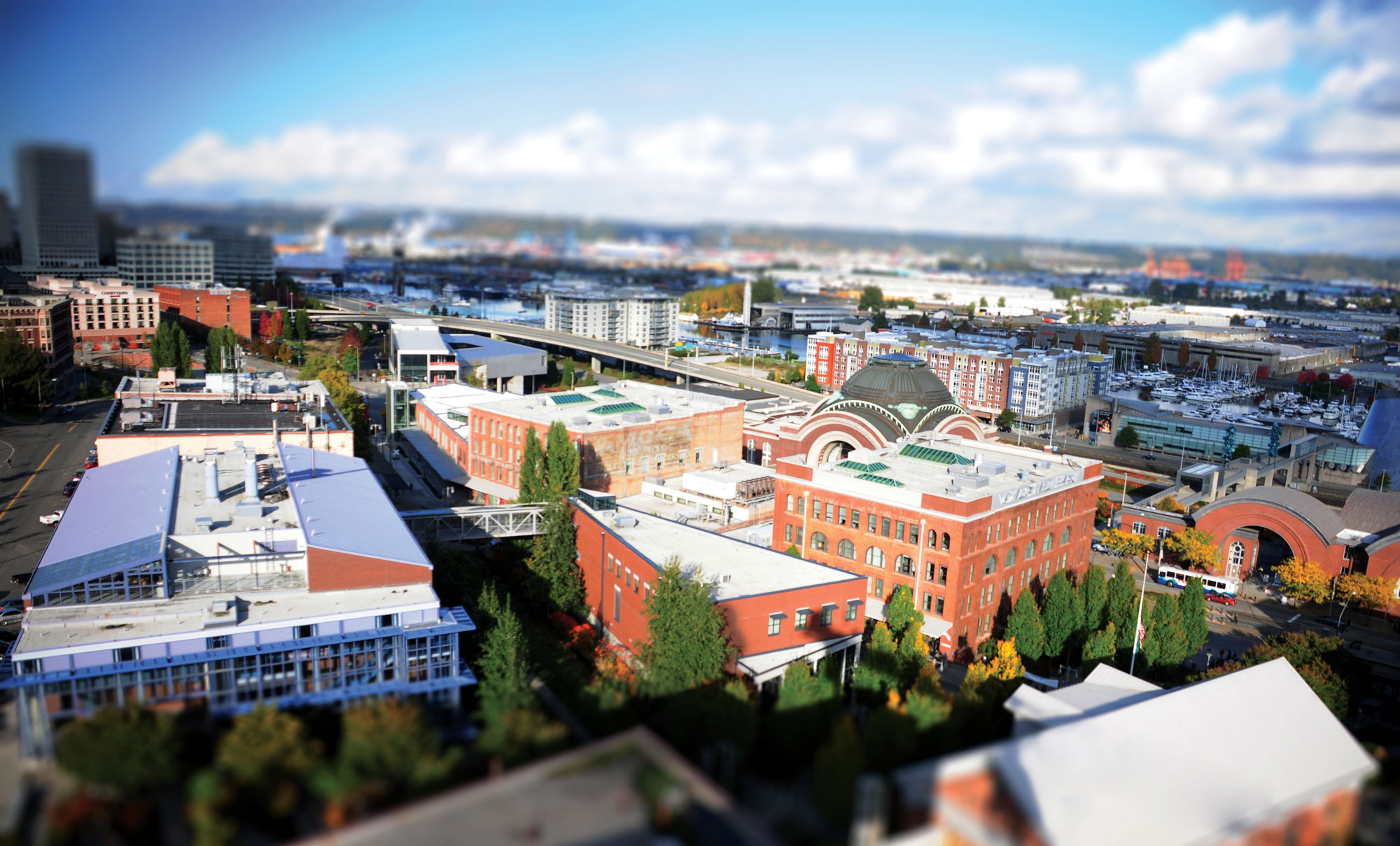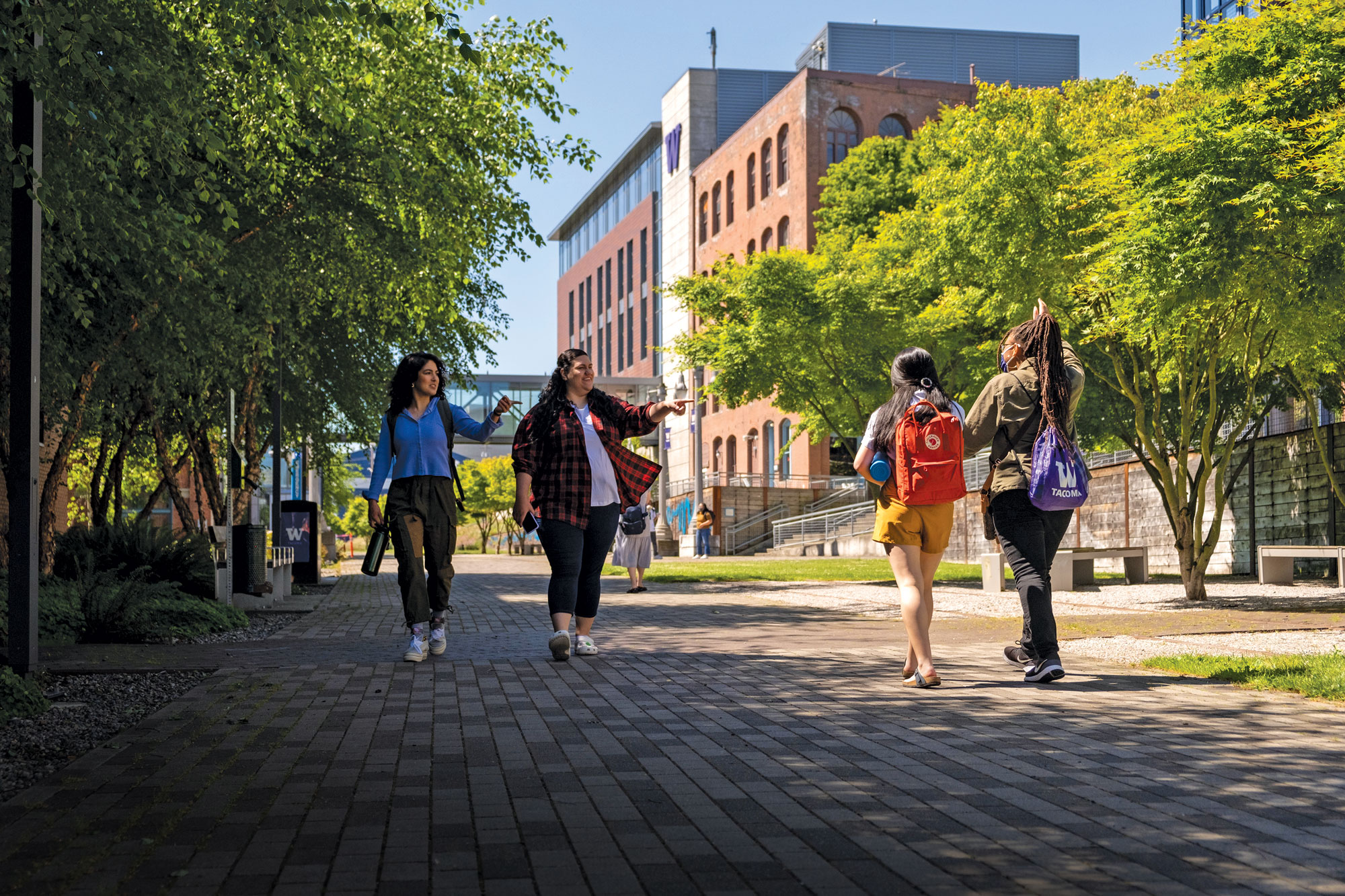A place of promise A place of promise A place of promise
For three decades, UW Tacoma has sought to serve not only its students but the community as a whole

For three decades, UW Tacoma has sought to serve not only its students but the community as a whole
When Danica Miller looks at the UW Tacoma campus, she sees more than the university where she has built her career in Native American studies, history, literature and art. She sees the school that her father, Bill Sterud, the Puyallup Tribal chair, helped break ground for 35 years ago. She sees a place of learning for historically marginalized students, a home for Indigenous teaching and learning, a growing number of faculty of color and a new minor in Native American studies. And she celebrates that all this is taking place on the homelands of her ancestors.
“I feel so fortunate to be doing this work we are now in these ways of cultural awareness and acknowledgement, but also in far-reaching pathways with other tribes as well as on-the-ground work with Indigenous students,” she says.
Forty years ago, the neighborhood where UW Tacoma now stands was a derelict commercial area troubled with crime and empty warehouses. The city was in an economic downturn and its deep-water port, Commencement Bay, was listed as one of the most toxic waterways in the country.
Elected officials, businesses and community leaders banded together to turn Tacoma around, seeking to make it safer for residents and more inviting to commercial interests. They needed to highlight the region’s rich natural beauty and cultural diversity, bolster the economy and improve access to education. They hit on the idea of trading crime and grime for college students. Setting their sights on a UW branch campus, they began courting legislators to support the cause.
A study revealed the population of South Puget Sound was profoundly underserved by public higher education. The region had fewer bachelor’s degrees than most urban areas of the state, and many potential students were place-bound—by families, jobs and limited resources—and didn’t have access to four-year public degrees or graduate programs. The findings, in turn, won over the state’s leaders to support not only a UW branch campus in Tacoma but one in Bothell as well.
The Tacoma leaders’ dream became real in 1990, when UW Tacoma welcomed its first students. Though it had just 13 faculty and 187 undergraduates—and in a temporary location—it was a turning point for the city.
Today the Tacoma campus one of the most diverse in the state: 63% of undergraduates are students of color, and the majority are the first in their family to attend college. With nearly 5,000 students overall, it embraces its role as an urban-serving university. The students and faculty are engaged in the community through service learning and community service, as well as through research and scholarship.
Mayor Victoria Woodards, a lifelong resident of the city, remembers the day the UW Tacoma campus opened and that the city was forever changed. “What’s so great about the people at UW Tacoma is that they use the resources of the students and the faculty not just to provide education inside the UW but also outside in the community,” she says. “Those are resources that a city can’t pay for.” Of course, there’s economic benefit to bringing students into the downtown core, but there’s so much more, she says. For example, the students take on research projects that can improve the city leaders’ understanding of specific problems and “give us ideas that can shape the city,” she says.
From its founding, the Tacoma campus has always been focused on the bigger picture, “committed to addressing issues of interest in the community,” says Sheila Edwards Lange, UW Tacoma’s chancellor. Whether that’s equitable economic development that supports women- and minority-owned busineses or reaching older and first-generation students, or expanding the teacher pool—from preschool to college—with more diverse and culturally competent educators, the Tacoma campus is working on it, she says. That community-serving commitment also has manifested in programs to improve water quality, address gentrification and housing needs, and work with small businesses to help them adapt to a changing economy.
Over its first two decades, UW Tacoma focused on building the faculty, student body and campus—today it offers nearly 40 undergraduate degrees and 14 graduate degrees. Around 2011, campus leaders started to position UWT as a major resource for the community—emphasizing education and opportunity for South Puget Sound residents and directing scholarship and research to meet the broader needs of the region.
As the campus grows more aware of the needs of its students and the greater community, it adds programs, creates projects and pursues community engagement to meet them, says Edwards Lange. In recent years, the school has expanded the diversity of the faculty to be more in line with the diversity of the student body—bringing in more teachers from underrepresented backgrounds and building on a foundation of leading scholars. They include Carolyn West, a nationally recognized clinical psychologist with an expertise in domestic violence and women’s empowerment with a particular focus on Black women, and Rubén Casas, who explores public space and civic engagement and advocates for adapting Tacoma’s downtown to increase pedestrian traffic and public use. Danica Miller, who now co-leads the tri-campus UW Center for American Indian and Indigenous Studies, brings Indigenous ways of learning, (Lushootseed) language preservation and Indigenous community connection.

Students greet each other on campus. Photo courtesy of UW Tacoma.
When Rachel Endo came to Tacoma to be the founding dean of the school of education, there was work to do to address the shortage of K-12 teachers—particularly teachers from underrepresented backgrounds and those who were prepared to incorporate anti-racist and equity-centered practices. The need led UW Tacoma to create a new bachelor’s degree in education in 2022 that uses service learning, psychology and inclusive practices. While it won’t completely solve the problem of too few teachers, the effort will create a steady stream of culturally competent teachers for Tacoma’s classrooms. Meanwhile, the UWT also expanded its educational leadership offerings to include a focus on Indigenous graduate students. A new program with the Muckleshoot Tribal College celebrated the first cohort of Muckleshoot Scholars completing their doctorates last spring.
In 2017, UW Tacoma became a federally designated Minority Serving Institution. Last year, this coveted acknowledgment brought a $2 million award from the U.S. Department of Education to support Asian American, Native American Pacific Islander and low-income students. Endo, the principal investigator for the project, says the grant benefits students in every field of study on the Tacoma campus. About a quarter of the UW Tacoma students is Asian American or Pacific Islander, and more than half come from low-income backgrounds. Tacoma has significant enrollment of Vietnamese, Filipino and Korean American students, as well as a number from Samoan and Guamanian descent.
The campus itself serves Tacoma in myriad ways. When it opened at its permanent site on the south edge of downtown in 1997, it brought new life to the landscape, which has served changing communities over the last 180 years. For the white settlers in the 1850s, it was prime real estate for shipping and commerce thanks to the deep waters of Commencement Bay.
But it also has a troubled history. For the wave of Chinese immigrants who came to work on the railroad and stayed to help build wharves and warehouses in the mid-1800s, it became a place of tragedy as a wave of anti-Chinese sentiment in the 1890s triggered a mob to drive the immigrants from the city and burn their buildings to the ground. The rough history of exclusion replayed 60 years later when a thriving Japantown—some of which was on the site of the current UW Tacoma campus—was abandoned as hundreds of families were forced into concentration camps during World War II.
Today, UW Tacoma joins the citywide movement to acknowledge the troubled history, embrace the community’s current diversity and make changes toward becoming a more equitable, anti-racist city. Now perched on this land with so many layers of history—and history of diversity—UWT’s faculty, students and alumni are deep into the work of clarifying and celebrating the history and cultures of the area, owning the harm that has occurred and serving new generations of Tacomans. “That is the role of the public university,” says Edwards Lange.